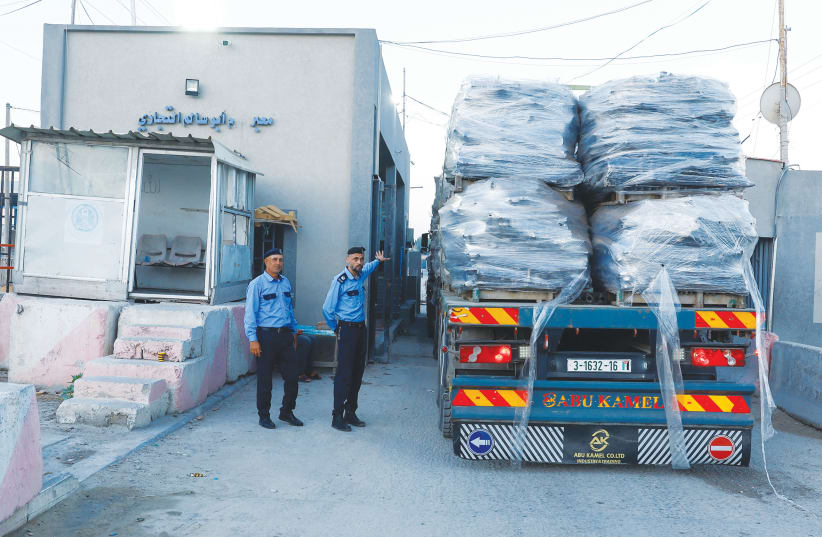One of the many questions arising in the wake of the October 7 Hamas terror attack on southern Israel is the sources of the organization’s funding for its military buildup and control over the Gaza Strip. Qatar is the answer that immediately comes to mind, but the data point to a more complex and disturbing answer.
The Gaza Strip is one of the poorest places in the world, but the Hamas regime in Gaza is quite rich. Since taking power in 2007, it has developed five funding channels: four of them operate under arrangements to which Israel is a party or are subject to its supervision.
Combined, these channels generate $2 billion to $2.5 billion a year for Hamas. This is a huge sum compared to the size of Gaza’s economy. By comparison, the Palestinian Authority (PA) budget, net of the sums transferred to the Gaza Strip, is slightly more than $3 billion a year. Some of the funds from these five channels are used to finance civilian public services, and the rest to fill the Hamas arsenals.
How does Hamas make money?
The PA budget is the most important and largest despite the fact that Hamas violently expelled the PA from Gaza in 2007. Its annual scope is estimated at more than $1 billion. These sums are transferred through the banking system supervised by Israel. They pay the salaries and pension contributions for 40,000 Gaza government employees as well as covering some civilian expenses. The PA also pays for Gaza’s water, power and medical services, transferring millions of dollars a year to Israel, which provides the services.
Qatar is the second funding source. The Qatari aid was previously delivered through Israel in suitcases bulging with cash. Today it is transferred through banks under UN supervision and with Israel’s approval. Its total scope is estimated at $400 million annually. This money finances welfare payments, part of the salaries of Hamas civilian and military wing employees, and civilian expenses, such as fuel for the Gaza power plant. This money, as far as is known, is hardly used for military procurement.


Customs duties and taxes collected by Hamas provide additional revenue sources. These include high customs duties and taxes on imports from Egypt brought in through the Rafah crossing, as well as “taxes” imposed by Hamas on smugglers of goods. In the past, these smugglers operated through tunnels on the Gaza Strip’s border with Egypt.
AFTER THE Egyptians destroyed the tunnels, smuggling continues through various ways, though at a smaller scale. A significant part of goods imported via the Rafah crossing are items with a high “tax component” (fuels, cigarettes, etc.). All these taxes go to Hamas, as it has absolute control over this route.
Hamas also imposes import taxes, fees, and various payments on imports from Israel that enter Gaza through the Kerem Shalom crossing. Combined, these two channels of “tax revenue” constitute the second largest component of the Hamas regime funding – about half a billion dollars a year.
All these “taxes and customs” are illegal under international customs regulation as well as the Paris Protocol (signed between Israel and the Palestinian Liberation Organization, aka the PLO, on 29 April 1994, and incorporated with minor amendments into the Oslo II Accord of September 1995) and other agreements between Israel and the PLO or the PA. They are levied at the expense of taxes and fees that the PA is supposed to collect to cover its own expenses for financing civilian services in Gaza. This unsupervised source pays the salaries of the Hamas military apparatuses, as well as paying for military equipment.
The fifth source is Iranian aid, donations from Hamas supporters, and other sources abroad. It is difficult to estimate the extent of these funds, which are transferred in convoluted and roundabout ways. Some of the aid is in the form of military equipment smuggled into Gaza, and some is cash transferred through money changers. These various sources probably amount to several hundred million dollars a year, almost all allocated for military equipment and other military uses.
These estimates indicate that more than two-thirds of the Hamas “budget” is channeled through the PA, or at its expense, and its transfer is made possible with Israel’s approval or consent. Along with the Qatari aid, this means that almost all Hamas funding is provided with Israel’s approval or consent. The only revenue source in which Israel is not involved are the “taxes” which Hamas imposes on imports through the Rafah crossing, as well as smuggling from Egypt to Gaza, the extent of which is unknown.
Its effective diversification of funding has provided Hamas with the resources to consolidate its control over Gaza and strengthen its military buildup, severely eroding the population’s standard of living.
For example, Gaza’s per capita national income, which was almost identical to that of the West Bank prior to the Hamas takeover, has fallen to only one-third of the West Bank’s. This figure illustrates the depth of Gaza’s economic crisis even before the war, and the abject exploitation of Gaza’s population by Hamas. Presumably, the war inflicted by Hamas on Israel will lead to a major humanitarian disaster in Gaza that will require enormous and expensive rehabilitation.
The unfortunate conclusion is that the PA and Israel knowingly contributed to bolstering Hamas in Gaza. Israel’s failure, therefore, lies not only in poor intelligence and military preparedness, but also in negligence in tracing where and how the funding was used.
Prof. Elie Podeh is a Mitvim Institute board member and teaches at the Department of Islamic and Middle Eastern Studies at Hebrew University. Yitzhak Gal is an expert on the Middle East and Palestinian economies and a Mitvim Policy fellow. He has studied Hamas funding extensively.
